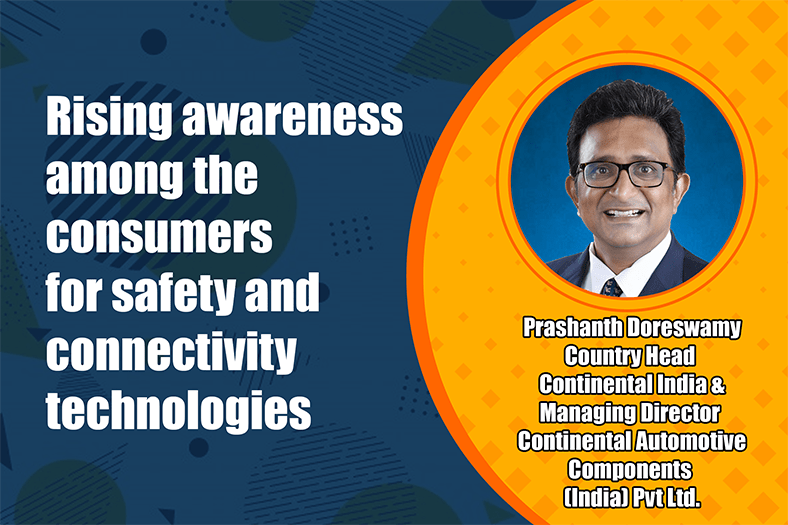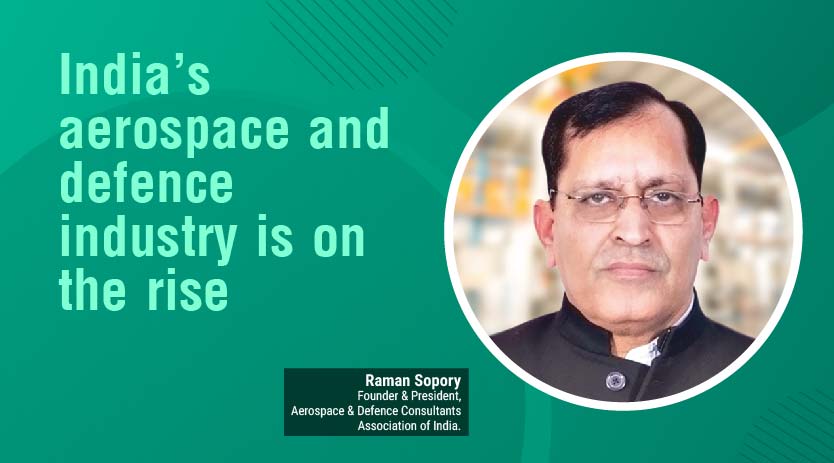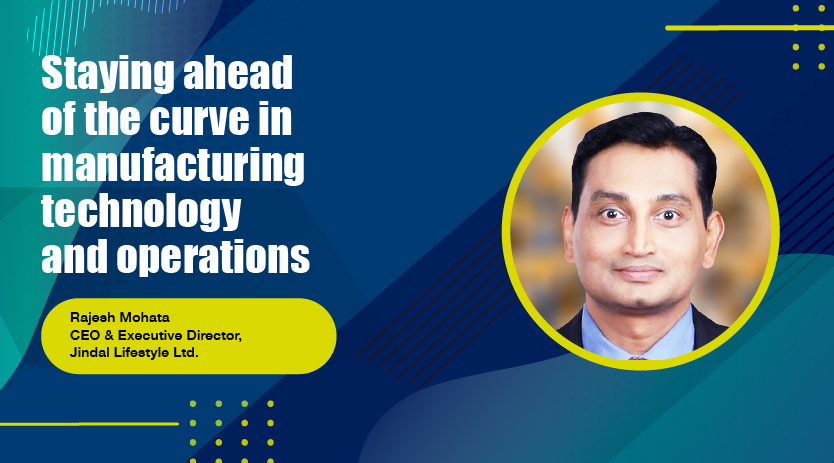Rising awareness among the consumers for safety and connectivity technologies
July 3, 2021 4:31 pm
With trends like connected, autonomous, and electric mobility, the industry across the globe is increasingly investing in the R&D of these technologies.
India is expected to be the world’s third-largest automotive market in terms of volume by 2026. With the present market trends, how can we make it a reality? The automotive industry in India is poised to grow, driven by megatrends connectivity, safety, and electrification. While the COVID-19 pandemic did disrupt the progress of the industry, but once we have control of the situation, the industry should show the same level of optimism as it did pre-COVID times. There were a couple of slow months last year, the demand surged post lockdown. In 2021, while the second wave has caused a slowdown in sales again, we are yet to understand the full impact—particularly given that it was not a complete, national-level lockdown. In addition, the government legislation-led changes will also have a positive impact on market improvement.
There are good chances of India becoming the third-largest automotive market in terms of volume by 2026. In the past few years, we have seen several favourable policies in the automotive sector. Safety features like ABS and airbags are now mandatory. With the implementation of BS-VI norms, India is on par with the world in emission norms. This opens up several opportunities for export from India. Production-Linked Incentives (PLI) is another initiative introduced recently that will also encourage local manufacturing and exports. There is also a rising awareness among the consumers for better safety and advanced connectivity technologies that are giving a push for the introduction of new technologies in the Indian market.
Once a feature is mandated, it becomes the norm, and today’s consumers expect substantial upgrades with every facelift and new launch of vehicle variant. This drives OEMs to optimise and include new features in the packaging. If we further delve into the preference of consumers, it is interesting to know that they are looking out for advanced and sustainable, safe, and convenient technologies in vehicles, creating new opportunities for OEMs and technology companies like us. Lastly, we have a credible, talented workforce that is capable of elevating the stance of the automotive industry. This is crucial for us to become globally competitive and recognised.
How is the industry leveraging the benefits of the PLI scheme, and what kind of changes are happening around the industry?
FDI is crucial to make India a significant part of the global supply chain, to help India manufacture for the world than just for the country. It will help make Indian products competitive, enhancing exports and growth in the country. The government’s PLI scheme is an excellent initiative and will help drive localisation by raising India’s bar as a global manufacturing hub. The scheme has the potential to create nearly 1.40 crore person-months’ worth of jobs directly from 2021-2022, which translates to effectively doubling the existing workforce across sectors.
This would further stimulate the MSME sector of our country. As per the government’s announcement in late 2020, the automotive sector will receive subsidies worth `57,000 crores, the largest share, as part of the scheme. But at the same time, the eligibility criteria for the automotive sector are more stringent, making it difficult to allow many automotive companies to avail the benefits under this scheme. We await further clarity on the four plans proposed for the automotive sector. In the current pandemic time, multinational firms have realised the issues of concentrating their manufacturing base in a few geographies. So, India is pitching itself to be part of this global supply chain by attracting investments in these PLI sectors at the right moment. Despite a growing domestic auto ecosystem, India is a marginal player in global supply chains. PLI will help to change this aspect. However, incentives alone may not be sufficient to convince firms to shift to India and create a separate ecosystem unless the local market also generates sufficient demand.
Indian automobile industry contributes to 6 percent of GDP and job opportunities. How will the ongoing trends impact the employment opportunities across the automobile industry?
With trends like connected, autonomous, and electric mobility, the industry across the globe is increasingly investing in the R&D of these technologies, and India’s rich talent pool is well suited to support this transformation. Moreover, with schemes like PLI, etc., India has become an attractive location for companies to set up their manufacturing units in India, creating more employment.
At Continental, with our “in the market, for the market’ approach, we have been continuously investing in India. For instance, we have heavily invested in our manufacturing efforts ranging from ABS assembly, expanding capacities for airbag control units in Bengaluru and wheel speed sensors in Manesar, manufacturing of instrument clusters, and a wide range of ECUs for different electronic applications. We have also made significant investments in R&D in India. Technical Centre India (TCI), with a strength of over 4,000 engineers, is one of the company’s Holistic Engineering and Technologies organisation (HE[a]T). TCI supports both local and global R&D for the company’s Automotive Technologies group sector.
The Indian government is pushing to flourish Electric Vehicles in India. Do you think that the present market trends will further lead to maximum transition towards EV?
According to a Bloomberg NEF report, it is estimated that India will become the fourth largest market for EVs by 2040. The Government of India has set an ambitious target of becoming 30 percent electric by 2030. But to be able to meet the target, we need to develop a comprehensive plan with a focus on manufacturing, R&D, and adoption. Currently, the EV industry in India is close to 1 percent of the entire automotive sales.
But it is picking pace with FDIs, new manufacturing hubs, and an increased push to improving charging infrastructure. In addition, federal subsidies and policy favouring deeper discounts for Indian – made electric two-wheelers and a boost for localised ACC battery storage production are other growth drivers for the Indian EV Industry. For maximum EV push, we need to innovate EV technologies beyond the powertrain of the vehicles—for instance, vehicle brakes. At Continental, we have something called the ‘One-Box Brake-By-Wire Solution’. Several functionalities are coupled to make this brake-by-wire solution more space efficient and energy-efficient. It integrates the brake actuation, the brake boosters, and the control systems into a single, compact, and weight-saving module, and it also helps reduce carbon emissions. We also offer the MK C2, the next generation of the One-Box brake-by-systems, that provides 100 percent efficient regenerative braking and will be critical for the EV market.
As we deal with the second wave of Covid-19 and face a labour shortage, scarcity of raw materials, how the Indian automobile industry is coping with these challenges?
The pandemic has created some uncertainties in the automotive sector. Though companies have resumed their production post the second wave, regulatory uncertainties, labour shortage, and growing concerns about health and safety would remain a point of concern. However, thanks to the technological shift that has taken place over the past two decades, including the evolution of Industry 4.0, the industry is in a better position now to handle these challenging times. For Continental, the significant challenges were in operations – both production & supply chain. But we quickly reacted to the situation and took the necessary. In addition, our Industry 4.0 practices and lean processes have helped us keep our production schedules OnTrack. Moreover, we are always in touch with our customers, continually understanding the changes, operating procedures, and requirements, which fast-tracked our operation resumption in a phased manner. At Continental, we are already using multiple Industry 4.0 technologies.
A low-cost automation concept called Chaku-Chaku has also been adopted to help us improve the efficiency of our production lines. Globally, Continental Supply Chain Management had already started its journey towards digitalisation and Industry 4.0, but the COVID-19 gave a new push to the movement. The vision is to have an autonomous supply network by adopting smart factory solutions and implementing AGVs, automatic replenishments, MES, and big data analytics. Some of the other tools like TOMS (Transport Order Management Systems), Increasing EDI & ASNs based supplies in our inbound logistics and using only GPS enabled vehicles in outbound logistics across all our plants, and using data lake and Continental Cloud services, have helped us in moving towards the digitisation journey of our SCM function.
3D printing and robotics are widely being implemented across industries. How is it really helping to add more precision in design and final production in your industry?
3D printing has changed the way vehicles are designed. Whether it’s a commercial vehicle, truck, or racing car, the technology offers automotive engineers and designers the tools to test the limits of design and performance. As for robotics, according to a recent PwC report, more than half (59 percentage) of manufacturers are already using some form of robotics technology. The advent of Robotic Process Automation (RPA) has always been a critical milestone for the manufacturing industry. RPA allows manufacturers to streamline operations and reduce the complexities of various processes, thus creating a more agile system. At Continental, we strongly believe in using technology to make our lives simpler and safer. As part of our Industry 4.0 initiative, we have been using 3D printing for the production of spare parts meant for machines and equipment We also have implemented the use of Cobots and robotic arms at our Bangalore plant, undertaking repetitive mechanical tasks.
What can be the potential threats and challenges in automated and robotic vehicles/processes?
With India moving towards digital technologies and connected mobility, cybersecurity has become an essential part of our systems. A vehicle, similar to any other device connected to a network, can be hacked. Hackers might be motivated to hack into the vehicle’s system to steal vital information of the passenger or meddle with the car’s functionalities. The multiple-OS format might also create loopholes that enhance the threats. Earlier, our concern was to protect the environment from faulty components. Today, it is equally important to protect the components from a hostile environment. To do this we need a qualified workforce, advanced technologies, support of AI & machine learning, and of course a significant number of manhours.
Speaking from a manufacturing perspective, the transformation towards robotics, Industry 4.0 has given a boost to Big Data and connectivity. These technologies have enabled manufacturers to optimise their processes, make more informed decisions that were earlier not possible. However, much like in automobiles, this has opened doors for threats and vulnerabilities, leading to gaining access to intellectual property, rewriting the codes of products to make them faulty and life-threatening, etc. Therefore, having resilient cybersecurity systems has become a must today. In addition, we need to combine multiple systems today, like combining intrusion detection systems with cyber-threat intelligence. It will allow detection of attacks at a much earlier stage, thus reducing the potential damage.
With the wide adoption of automation and robotics across industrial applications and processes, how do you foresee impacts on manpower?
Automation and robotics have transformed businesses and increased productivity across the industries. Some of the ways It will impact the workforce are: Create a safer work environment – Robotics can take care of tasks that need to be done in hazardous work environments – Create more opportunities for strategic roles – RPA can perform repetitive tasks with precision, thus allowing people to take up more strategic roles; New skills would be required – much like any change, RPA implementation would need to be accompanied by upskilling, reskilling, and cross-skilling for the new job roles.
Continental believes that smarter machines are pivotal for the growth of the manufacturing industry and practices. To live up to the pace of competitiveness in the era of digitalisation, every industry has to look at improving efficiency and build excellence. Smart factories upgrade the role of operators, increases the scope and quality of work, and will require smart leaders to manage them.
Cookie Consent
We use cookies to personalize your experience. By continuing to visit this website you agree to our Terms & Conditions, Privacy Policy and Cookie Policy.



















 English
English Hindi
Hindi